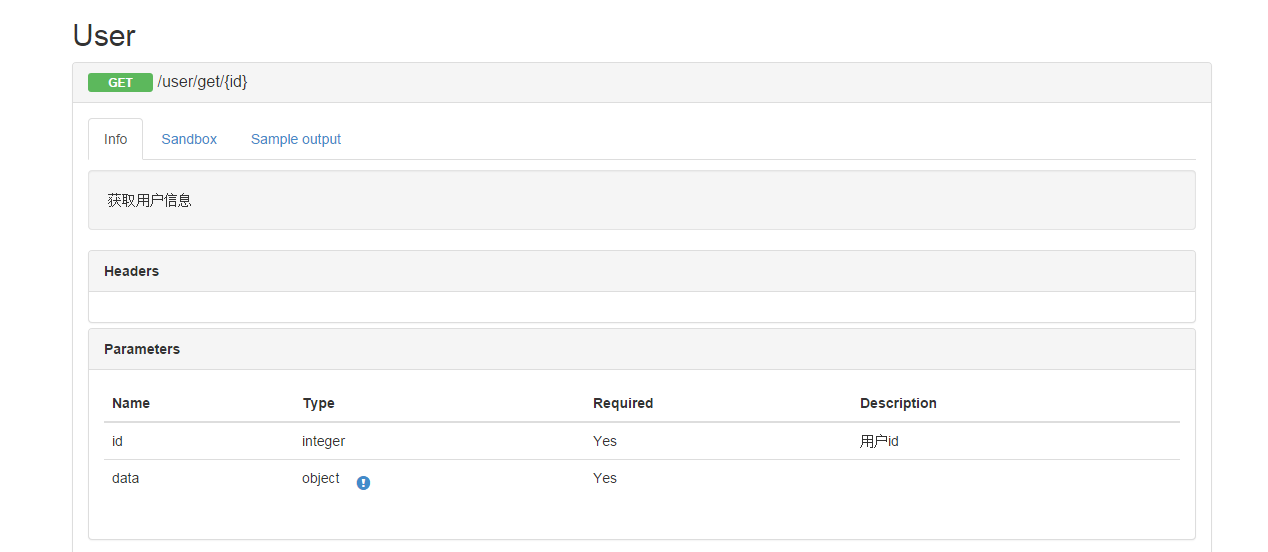相信不少码农做过 api 的开发,可能好不容易完成功能后,满以为可以悠哉了去看妹子,结果经理来了一句 把 api 文档也写了吧。 wtf! 最讨厌写文档了,然后又打开代码,慢慢的一个一个对照写文档,质量可想而知。
前段时间罗飞老师在讲 api 分层构建的时候提到开发 api 的几个方面,其中一个就是 API 文档自动生成机制,试想如果在编写代码的同时,可以直接通过某种方式把这个 api 也描述清楚,最终只要执行某个脚本就可以自动生成 api 文档,clean and fast~
php-apidoc 就是这样一个自动化的 api 生成工具,使用 php 编写,只需要在方法的注释里加上相应的规则即可,原理是通过 php 的反射机制动态获取 annotation, 然后做相应处理.
## 安装
推荐使用 composer 安装,把下面的代码加入到 composer.json 中,同时为了测试 另外在项目根目录下 建立一个 src 目录,里面放一个 user.php 文件 采用 psr-4 加载。 所以最终 composer.json 代码如下。
1
2
3
4
5
6
7
8
9
10
| {
"require": {
"crada/php-apidoc": "@dev",
"autoload": {
"psr-4": {
"Acme\\": "src/"
}
}
}
}
|
执行 composer update 即可
## 使用
假设我们要开发一个 user 的 api 接口,使用 rest 风格,对应的 crud 方法如下:
1
2
3
4
5
6
7
8
9
10
11
12
13
14
15
16
| <?php
class User
{
//用于获取id为$id的用户信息
public function get($id) {}
//创建用户
public function create() {}
//更新用户
public function update() {}
//删除用户
public function delete() {}
}
|
然后准备一个入口文件作为执行脚本,这里建立一个 index.php 文件
1
2
3
4
5
6
7
8
9
10
11
12
13
14
15
16
17
18
19
20
21
| <?php
use Crada\Apidoc\Builder;
use Crada\Apidoc\Exception;
require "vendor/autoload.php";
$classes = array(
'Acme\\User'
);
$ouput_dir = __DIR__ . '/apidocs';
try {
$builder = new Builder($classes, $ouput_dir, '接口文档V1.0', 'api.html');
$builder->generate();
} catch (Exception $e) {
echo "error ", $e->getMessage();
}
|
执行后 在 apidocs 目录下回生成一个 api.html 访问如图:

api 方法怎么木有?这不是坑爹吗。。
别急,接下来我们来开始写 api 对应的方法。
官方提供的一些方法如下
@ApiDescription: 定义某个接口的描述 其中 section 参数作为分组,description 作为描述
@ApiMethod: 定义接口的请求方法,参数为 type, 可选值有 get|post|put|delete
@ApiRoute: 定义接口请求地址 参数为 name
以上三个为必填项
接下来有一些可选方法
定义请求参数: @ApiParams(name="...", type="...", nullable=..., description="...", [sample=".."])
定义请求头: @ApiHeaders(name="...", type="...", nullable=..., description="...")
定义响应头: @ApiReturnHeaders(sample="...")
定义响应结果: @ApiReturn(type="...", sample="...", [description="..."])
其中参数的 type 类型可以是 'object', 'array(object) ', 'array', 'string', 'boolean', 'integer', 'number'
1
2
3
4
5
6
7
8
9
10
11
12
13
14
15
16
17
18
19
20
21
22
23
24
25
26
27
28
29
30
31
32
33
34
35
36
37
38
39
40
41
42
43
44
45
46
47
48
49
50
51
52
| <?php
namespace Acme;
class User
{
/**
* @ApiDescription(section="User", description="获取用户信息")
* @ApiMethod(type="get")
* @ApiRoute(name="/user/get/{id}")
* @ApiParams(name="id", type="integer",nullable=false,description="用户id")
* @ApiParams(name="data", type="object",sample="{'user_id': 'int', 'user_name':'string','profile':{'email':'string','age':'integer'}}")
* @ApiReturnHeaders(sample="HTTP 200 OK")
* @ApiReturn(type="object", sample="{
* 'transaction_id' : 'int',
* 'transaction_status': 'string'
* }")
*/
public function get() {}
/**
* @ApiDescription(section="User", description="创建用户")
* @ApiMethod(type="post")
* @ApiHeaders(name="header_key", type="string", nullable=true, description="test_header_key")
* @ApiRoute(name="/user/create")
* @ApiParams(name="username", type="string", nullable=false, description="用户名")
* @ApiParams(name="email", type="string", nullable=false, description="邮箱")
* @ApiParams(name="password", type="string", nullable=false, description="密码")
* @ApiParams(name="age", type="integer", nullable=true, description="年龄")
* @ApiReturn(type="object",sample="{'user_id':'int','profile':{'email':'string','age':'integer'}}", description="用户信息")
*/
public function create() {}
/**
* @ApiDescription(section="User", description="更新用户")
* @ApiMethod(type="put")
* @ApiRoute(name="/user/update")
* @ApiParams(name="id", type="integer", nullable=false, description="用户ID")
* @ApiReturn(type="boolean",sample=true, description="用户更新结果")
*/
public function update() {}
/**
* @ApiDescription(section="User",description="删除用户")
* @ApiMethod(type="delete")
* @ApiRoute(name="/user/delete")
* @ApiParams(name="id", type="integer", nullable=false, description="用户ID")
* @ApiReturn(type="boolean",sample=true, description="用户删除结果")
*/
public function delete() {}
}
|
再次执行 php index.php 我们发现已经有对应的 api 方法了

界面还是挺美观的,不同的请求也有不同的着色。
打开每个单独的请求都会有三个 tab 标签

第一个 info 主要是接口的一些请求信息。
第二个 sandbox 提供了一个测试的功能 我们可以在上方的 Api Url 里面填上对应的测试 url, 然后在 sandbox 里填入测试参数 点击 send 即可看到返回结果
第三个主要是一些样例的返回信息
至此介绍结束。 我觉得对于码农来讲,在遇到繁杂的事物时,要学会思考,怎么样才能更快更高效的完成任务,要遵循 KISS 原则。 有时候学会偷懒也是一种能力。




